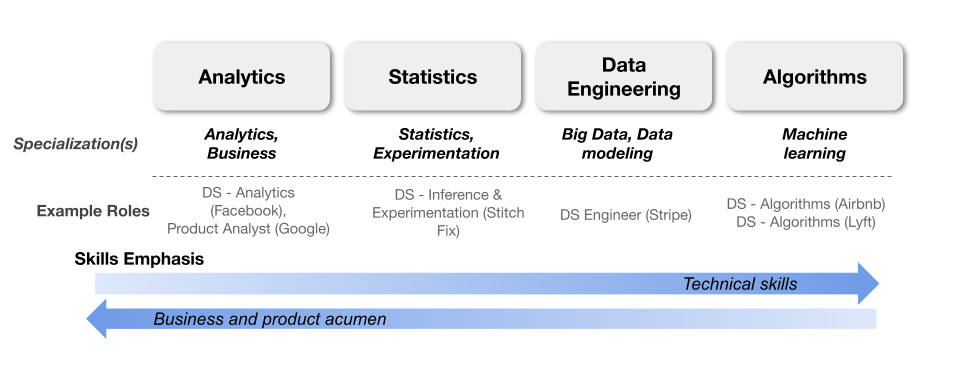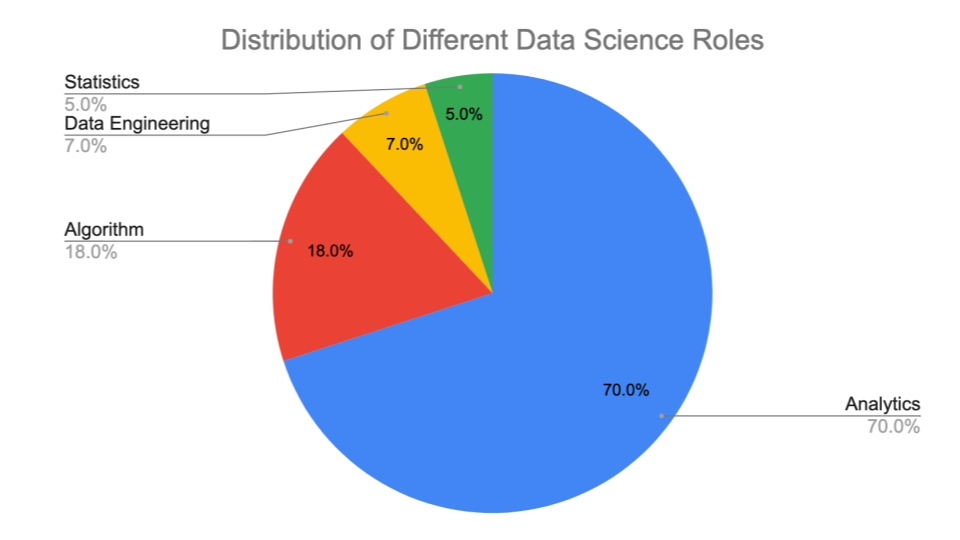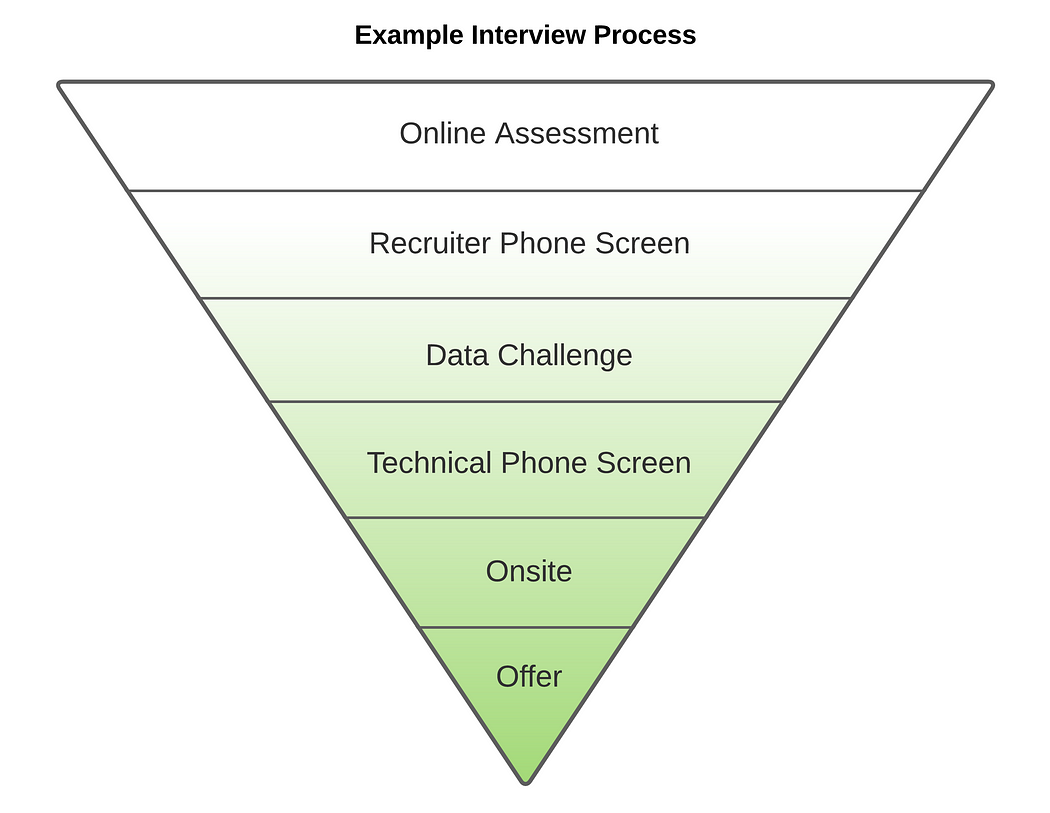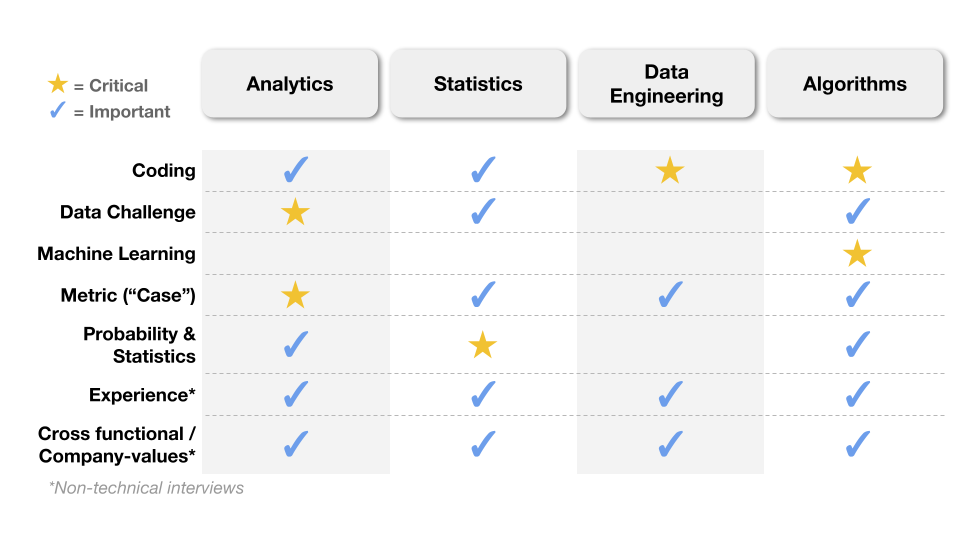Interviewing for Your First Data Scientist Job: What to Expect and How to Prepare
Feb 14, 2023
How do you become a data scientist? There’s so much information out there that it can be difficult to know where to even start.
That’s why in this post we're going to look at just 4 areas to get you started on your journey and land your first data science job.
Different Types of Data Science Roles
If you’ve done any looking for data science jobs already, you might be confused by all the job titles. With various titles like Product Data Scientist, Machine Learning Data Scientist, and many more, which positions should you apply for?
We can break the options down into just four main roles:
- Analytics - Drives business impact by making recommendations based on data insights.
- Statistics - Identifies opportunities to scale experimentation and implements statistical approaches (eg., causal frameworks) to solve business challenges.
- Data Engineering - Builds scalable data pipelines to enable data-driven decisions, typically for data-savvy consumers (analysts and Data Scientists).
- Algorithms - Creates business value by developing statistical, machine learning, and optimization models.

Although each role is unique, these are all data science positions, and they do overlap so is important to clarify exactly what the responsibilities of a role would be early in the hiring process.
Some roles are also more common than others in the job market. Here’s a diagram showing the distribution in the job market based on ~1,000 full-time data science job openings that were posted on LinkedIn in September — November 2020.

As you can see analytics is the dominating role which makes it a good option for starting your data science career. However, it’s also important to focus on the role that aligns with your interests and skills.
Now that you know more about the roles, let’s talk about the interviews.
The Interview Process
In this section, we will cover the different stages of the interview process, and later on, we will go into more detail about the types of questions you can expect.

Remember that every company is different. The process we are going over here is general, and you should expect different companies to have slightly different processes.
Stage 1: Online Assessment
This is usually completed on a coding website (eg., HackerRank) and does not involve a scheduled in-person interview.
- Typical Length: 30min — 1hr
- Types of Interviews: Coding
- Likelihood of Occurrence: 1 of 3
- Company Goal: To screen out uninterested candidates and those without minimum technical skills.
Stage 2: Recruiter Phone Screen
The recruiter will introduce the company, role, and sometimes, the team you are interviewing to join. The recruiter may ask about your background, timeline, and what you’re looking for in a new role (including compensation). This is a great time to ask questions about any concerns you have.
- Typical Length: 30min
- Types of Interviews: Behavior & Cross-function
- Likelihood of Occurrence: 3 of 3
- Company Goal: To ensure that the role, your interests, timelines, and requirements (eg., visa) fit well.
Stage 3: Data Challenge
The data challenge typically asks you to tackle a business case and provide recommendations based on sample data. Sometimes, you will be asked to write a summary document or prepare a presentation.
- Typical Length: 1 day — 2 weeks
- Types of Interviews: Coding
- Likelihood of Occurrence: 2 of 3
- Company Goal: To screen out uninterested candidates and test technical, problem-solving, and communication skills.
Stage 4: Technical Phone Screen
This usually starts with talking about your previous experience and then moves into technical questions which will vary depending on the role you are interviewing for. These can vary a lot, so it’s a good idea to ask your recruiter what to expect.
- Typical Length: 30min — 1hr
- Types of Interviews: Coding
- Likelihood of Occurrence: 2.5 of 3
- Company Goal: To test for the minimum technical skills needed for the role.
Stage 5: Onsite (typically 4–6 rounds)
This is the most challenging and will contain multiple interviews, with the ones included depending on the role you’re interviewing for. In the next section, we will dive deeper into the types of interviews you would encounter here.
- Typical Length: 4–6 hrs
- Types of Interviews: All
- Likelihood of Occurrence: 3 of 3
- Company Goal: To test most of the skills the role requires.
Types of Interviews
Let’s Look at the basics of 7 types of data science interviews.
Coding Interview
This interview can cover things from applied data extraction/manipulation to machine learning algorithms and computer science fundamentals. The questions will differ depending on the type of role, but you can expect SQL for any role.
Example Question
- Get the average purchases for each user (SQL).
Top Tips
- Before coding, walk through your intended plan with the interviewer first to clarify questions and validate your approach.
- Know the basics, but don’t try to memorize everything.
Resources
- Useful tips to ace the SQL interview (video).
- A comprehensive guide on preparing for Python questions (blog post).
Data Challenge
The candidate is asked to analyze sample data to make recommendations to solve a business problem. Problems can range from exploratory analysis to feature engineering and modeling exercises.
Example Question
- Given a dataset of customer behaviors, define customer churn and find factors that may affect customer churn.
Top Tips
- Have a clear understanding of the business problem before starting by researching the domain. Present solutions that focus on the problem at hand.
- Don’t assume the data is clean unless stated. Consider checking corner cases and looking for outliers. If you don’t have time to check the data, clearly state your assumptions.
- Summarize your work and provide the next steps (eg., areas of further exploration).
Resources
- Online community for solving various data challenges (Kaggle)
- Acing the Data Science Take-home Assignment (blog)
Metric (“Case”) Interview
You will be given a business scenario and asked to discuss your approach to solving a problem.
Example Question
- How would you investigate a negative metric shift in profit?
Top Tips
- Regurgitate the context and goal of the exercise before answering and ask clarifying questions.
- Ask the interviewer for a couple of minutes to write answers down and structure your communication before speaking.
- Consider briefly sharing multiple approaches first and asking your interviewer where to share more details, before giving your full answer.
Resources
- The Ultimate Guide to Cracking Business Case Interviews for Data Scientists (part 1, part 2)
- Most frequently asked metric questions and frameworks (video)
- Real metric question and answers (video playlist)
- 7 commonly asked A/B testing interview questions and answers (blog post)
Probability & Statistics Interview
This interview will test your understanding of applied statistics (eg., experimentation) and probability (e.g, Bayes theorem).
Example Question
- How would you describe a p-value/confidence interval to a 10-year-old?
Top Tips
- You may not need to know the exact formula for calculating a specific metric. However, you should know what the variables are and the direction in which it moves the output metric.
- For probability questions, you can often answer the question by drawing out the permutations (eg., with a tree) and adding up the probabilities. It is okay if you don’t get the exact right answer (eg., due to a math error), especially if your approach is right.
Resources
- Top 5 Stats concepts in data science interviews (video)
- Hypothesis testing questions and answers in data science interviews (part 1, part 2)
- Sampling and Simulation Problems in Data Science Interviews (video)
- Introductory Statistics and Probability course
Machine Learning Interview
This interview includes questions on machine learning fundamentals and solving problems using common techniques.
Example Question
- What is overfitting? How do you overcome overfitting?
Top Tips
- Give a concise definition in 2 to 3 sentences. Provide one or two examples to convince the interviewer that you have both theoretical knowledge and experience.
- If necessary, provide some common solutions to the problem.
Resources
- The Ultimate Guide to Acing Machine Learning Interviews (blog)
- 4 kinds of machine learning problems in data science interviews (video)
- Implementation of machine learning algorithms from scratch (playlist)
Experience Interview
You will discuss your previous professional experience. The questions are mostly non-technical, behavioral questions.
Example Question
- Tell me about a time you resolved a conflict or had to convince a stakeholder on an opposing viewpoint.
Top Tips
- Pause often and ask the interviewer if they have any questions or if they would like you to share more details on a specific topic.
- In preparation for the interview, determine 3–5 projects that can be used as examples for most behavioral interviews. Write down the context, challenges, your solutions, and impact so you don’t have to improvise during the interview.
Resources
- How to present past projects (part 1 and part 2)
- Amazon’s Leadership Principles
Cross-functional / Company values Interview
In this interview, you will be asked to give examples of how you collaborated in prior experiences and what you would do in hypothetical scenarios. The interview typically aims at identifying candidates who have a good fit of the company’s culture.
Example Question
- Tell me about a time your recommendation was at odds with somebody else. How did you achieve a solution?
Top Tips
- Review the “company values” (usually on the company website). Prepare situations in which you exemplified those values.
- If possible, research who your interviewers are beforehand. Visualize their challenges (eg., product managers may want to know how you provide data to stakeholders) and brainstorm past experiences that might relate well to those situations.
Resources
Preparation
How do you prepare for all those interviews?
Here are some general tips:
- Learn more about getting organized in your preparation process (video).
- Before the process, ask the recruiter about the types of interviews to expect (video).
- Once you know the process, prioritize preparation in the order of the interviews (eg., if the experience interview is first, prep for that). If you’re just getting started, prioritize the coding interviews first.
Your preparation will also depend on the type of role because certain interviews are more likely to appear for different roles. The chart below gives some insight.

This can give you a sense of where to prioritize depending on your strengths/weaknesses and the type of role you are applying for.
Attributes Assessed
While you do need hard technical skills that often is not enough to land a job. There are also some other qualities that you want to demonstrate throughout your interviews.
- Communication — Demonstrated by answering questions in a coherent and logical way and explaining technical concepts using examples and analogies.
- Business Acumen / Product Sense — Demonstrated by weaving the business and organizational context into account when answering questions.
- Problem Solving — Demonstrated through the breadth and depth of your answers.
- Collaboration & Influence — Demonstrated by your ability to take feedback during the interview and incorporate multiple viewpoints into your answers.
Here are 3 tips to help you show these attributes:
- Speak with the context and audience in mind.
- Don’t rush.
- Demonstrate your interest in the company by sharing your personal insights.
Closing Thoughts
We have covered a lot in this post, but before you go, here are the next steps we recommend if this is the beginning of your data science job search:
- Choose one role to focus on and prioritize the interviews most relevant to that path.
- Plan ahead.
- Be ready to sink time into the process.
- Practice, practice practice.
We hope this is been helpful! If you want to check out an even more detailed version of this post, look here.

